

Ladder of Feedback for Classroom Observation. How to Make Negative Feedback a Positive Thing. How to Make Negative Feedback a Positive Thing Someone said something to you that transformed the way you saw yourself.

It felt like a punch in the gut. It challenged assumptions you held about yourself. It confronted disappointing performance you hadn’t noticed or acknowledged. Get a GRIP before delivering feedback. Why aren’t effective, trust-building conversations happening in the workplace more regularly?

From where I sit as a former executive and now as a leadership development consultant and coach, there are three primary reasons: Technology has turned many people into automatons who use email, text, and social media as a replacement for authentic, thoughtful communication.It’s not rewarded and/or modeled by enough senior leaders, and thus does not pervade the culture.Most managers are uncomfortable with and/or ineffective at having conversations that fall outside the realm of triviality and/or praise. Easing the Stress of Evaluations for Administrators. My previous post explored making summative evaluations less stressful for teachers.
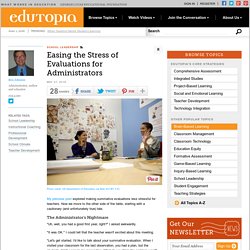
Now we move to the other side of the table, starting with a cautionary (and unfortunately true) tale. The Administrator's Nightmare. Work-Life Balance Is Easier When Your Manager Knows How to Assess Performance. Dave wheeler FOR HBR Not long ago, a manager asked me to name the most important work-life benefit for employees.
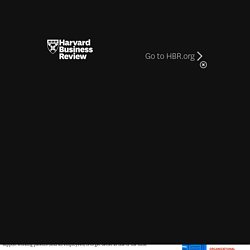
I answered that the most important benefit isn’t a benefit at all. Life Styles Inventory™ (LSI) How Your Teacher Observation Can Help You Grow. How Your Teacher Observation Can Help You Grow by Paul Moss For many, teacher observations are their biggest source of dread.
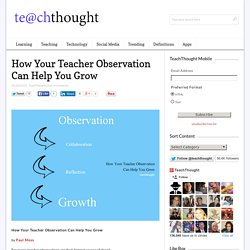
They stir feelings of nausea, spark vigorous and often angry debate about their efficacy, and are to be avoided at all costs. But with the trend of performance pay sliding into the education environment like a rattlesnake, the fear of observations has some very real and legitimate origins. No one wants to lose his or her job, or his or her pay rise. Here is some thinking (that can hopefully help) to turn observations into desirable opportunities for personal growth. Six Steps Toward an Employee Recognition Program. As supervisors are faced with the ebb and flow of production needs, companies must go beyond the simple mechanical acknowledgement of birthdays, years of service, and end of careers.
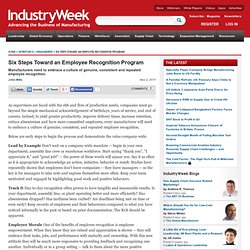
Indeed, to yield greater productivity, improve delivery times, increase retention, reduce absenteeism and have more committed employees, every manufacturer will need to embrace a culture of genuine, consistent, and repeated employee recognition. Below are early steps to begin the process and demonstrate the value company-wide. Lead by Example Don't wait on a company-wide mandate -- begin in your own department, assembly line crew or warehouse workforce.
Start saying "thank you", "I appreciate it," and "great job! " -- the power of these words will amaze you. Recognising Good Performance. Lesson Feedback. Professional Development: The Learning Walk. The Framework for Teaching. Secret Teacher: schools have got lesson observations all wrong. End of Year Reports: An Essential Part of Coaching - The Art of Coaching Teachers. My understanding of coaching deepens with every year I coach.
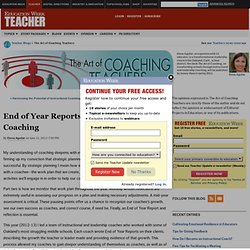
After this last year, I'm firming up my conviction that strategic planning is a key activity for a coach to be successful. By strategic planning I mean how we design the coaching work that we'll do with a coachee--the work plan that we create, the goals within it, and the identification of the activities we'll engage in in order to help our coachee meet her goals. That's part one. Part two is how we monitor that work plan throughout the year. Monthly written reflections are extremely useful in assessing our progress on a plan and making necessary adjustments.
This year (2012-13) I led a team of instructional and leadership coaches who worked with some of Oakland's most struggling middle schools. Express 8.19 - Supporting Teacher Growth with Instructional Rounds. Supporting Teacher Growth with Instructional Rounds Robert J.
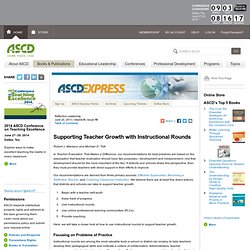
Marzano and Michael D. Response: Ways To Observe Teachers Without Demoralizing Them - Classroom Q&A With Larry Ferlazzo. Edutopia-stw-maine-project-learning-six-step-rubric-planning-successful-projects. Home. Policy Priorities:Quantifying Teacher Effectiveness:Quantifying Teacher Effectiveness. Spring 2013 | Volume 19 | Number 1 Quantifying Teacher Effectiveness Pages 1-3,5-7 Teachers matter.
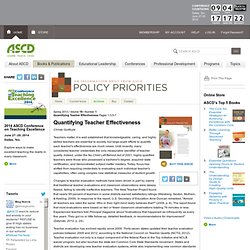
It is well established that knowledgeable, caring, and highly skilled teachers are essential to society, but large-scale efforts to quantify each teacher's effectiveness are much newer. Until recently, many considered teacher credentials the only measurable identifier of teacher quality. Indeed, under the No Child Left Behind Act of 2001, highly qualified teachers were those who possessed a bachelor's degree, acquired state certification, and demonstrated subject matter mastery. Today, focus has shifted from requiring credentials to evaluating each individual teacher's capabilities, often using complex new statistical measures of student growth.
Changes to teacher evaluation methods have been driven in part by claims that traditional teacher evaluations and classroom observations were deeply flawed, failing to identify ineffective teachers. States Move Forward, Unequally. Measuring Good Teachers. When the eight-day Chicago teachers’ strike ended last fall, organized labor celebrated a big win, but not over salary raises.
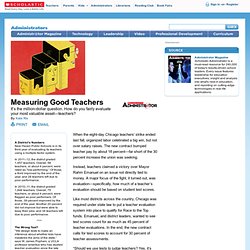
The new contract bumped teacher pay by about 18 percent—far short of the 30 percent increase the union was seeking. Instead, teachers claimed a victory over Mayor Rahm Emanuel on an issue not directly tied to money. A major focus of the fight, it turned out, was evaluation—specifically, how much of a teacher’s evaluation should be based on student test scores. Like most districts across the country, Chicago was required under state law to put a teacher evaluation system into place to qualify for Race to the Top funds.
Emanuel, and district leaders, wanted to see test scores count for as much as 45 percent of teacher evaluations. “Should we use tests to judge teachers? How to measure good teaching has been a third-rail question since 2009, when Race to the Top legislation offered federal funds to states that required “substantial” evaluation systems. —Spring 2013—